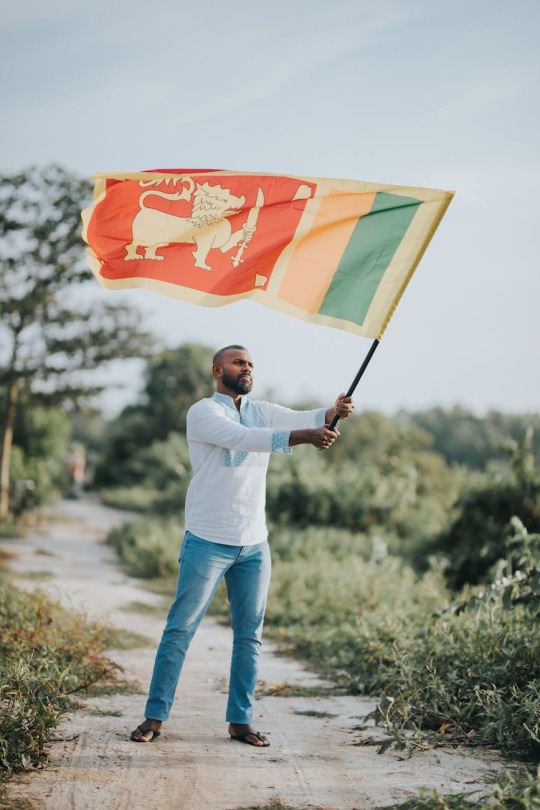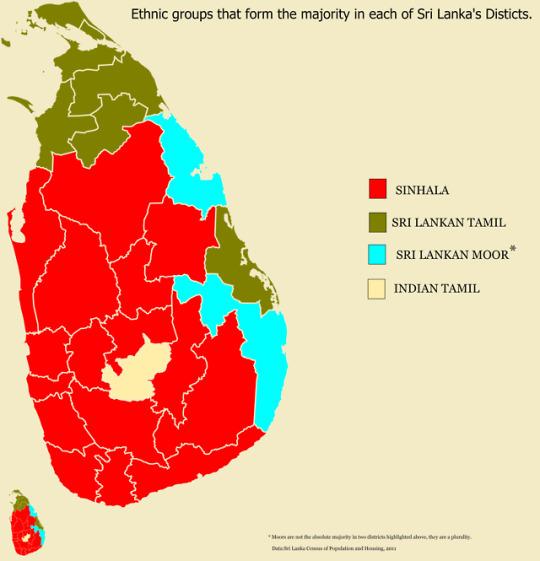#Colloquial Sinhalese
Text
Exploring the Richness of Sinhala: Sinhalese Language of Sri Lanka
Unveiling the Captivating World of the Sinhala Language
The Sinhalese language is a linguistic gem with deep roots in Sri Lanka’s vibrant culture and history. With its melodious tones and ancient origins, this Indo-Aryan language has fascinated linguists and culture enthusiasts alike. This article explores the fascinating intricacies of the Sinhala language, exploring its development, its…

View On WordPress
#accessibility#Colloquial Sinhalese#Cultural Significance#Indo-Aryan Language#Language Access#Language Evolution#Language Services#Language Shift#LanguageXS#Linguistic Diversity#Literary Sinhala#Pali Influence#Sanskrit Influence#Sinhala Alphabet#Sinhala Interpretation#Sinhala Language#Sinhala Script#Sinhala Translation#Sinhalese Speakers#SOV Word Order#Sri Lanka Heritage#Sri Lankan Culture#Subject-Object-Verb#Syllabic Script#Vedda Language
0 notes
Photo

Sri Lanka: Ethnic groups that form the majority in each district.
CheraCholaPandya:
Source
Sinhala:
The Sinhalese (Sinhala: සිංහල ජාතිය Sinhala Jathiya, also known as Hela) are an Indo-Aryan-speaking ethnic group native to the island of Sri Lanka. They constitute about 75% of the Sri Lankan population and number greater than 16.2 million. The Sinhalese identity is based on language, historical heritage and religion. The Sinhalese people speak the Sinhalese language, an Indo-Aryan language, and are predominantly Theravada Buddhists, although a small percentage of Sinhalese follow branches of Christianity. The Sinhalese are mostly found in North Central, Central, South, and West Sri Lanka. According to the 5th century epic poem Mahavamsa, and the Dipavamsa, a 3rd–5th century treatise written in Pali by Buddhist monks of the Anuradhapura Maha Viharaya in Sri Lanka, the Sinhalese are descendants of settlers who came to the island in 543 BCE from Sinhapura, in India, led by Prince Vijaya.
Sri Lankan Tamil:
Sri Lankan Tamils (Tamil: இலங்கை தமிழர், ilankai tamiḻar ? also Tamil: ஈழத் தமிழர், īḻat tamiḻar ?) or Ceylon Tamils, also known as Eelam Tamils in Tamil, are members of the Tamil ethnic group native to the South Asian island state of Sri Lanka. According to anthropological and archaeological evidence, Sri Lankan Tamils have a very long history in Sri Lanka and have lived on the island since at least around the 2nd century BCE. Most modern Sri Lankan Tamils claim descent from residents of Jaffna Kingdom, a former kingdom in the north of the island and Vannimai chieftaincies from the east. They constitute a majority in the Northern Province, live in significant numbers in the Eastern Province, and are in the minority throughout the rest of the country. 70% of Sri Lankan Tamils in Sri Lanka live in the Northern and Eastern provinces.
Indian Tamils in Sri Lanka:
Indian Tamils of Sri Lanka are Tamil people of Indian origin in Sri Lanka. They are also known as Hill Country Tamils, Up-Country Tamils or simply Indian Tamils. They are partly descended from workers sent from South India to Sri Lanka in the 19th and 20th centuries to work in coffee, tea and rubber plantations. Some also migrated on their own as merchants and as other service providers. These Tamil-speakers mostly live in the central highlands, also known as the Malayalam or Hill Country yet others are also found in major urban areas and in the Northern Province. Although they are all termed as Tamils today, some have Telugu and Malayalee origins as well as diverse South Indian caste origins. They are instrumental in the plantation sector economy of Sri Lanka. In general, socio-economically their standard of living is below that of the national average and they are described as one of the poorest and most neglected groups in Sri Lanka. In 1964 a large percentage were repatriated to India, but left a considerable number as stateless people.
Sri Lankan Moors:
Sri Lankan Moors (Tamil: இலங்கைச் சோனகர், translit. Ilaṅkaic Cōṉakar; Sinhalese: ලංකා යෝනක, translit. Lanka Yonaka formerly Ceylon Moors; colloquially referred to as Muslims or Moors) are an ethnic minority group in Sri Lanka, comprising 9.3% of the country's total population. They are mainly native speakers of the Tamil language with influence of Sinhalese and Arabic words. They are predominantly followers of Islam.
The Moors trace their ancestry to Arab traders who settled in Sri Lanka in waves beginning from the 8th century. The population of Moors are the highest in the Ampara, Trincomalee and Batticaloa districts. The Portuguese named the Muslims in India and Sri Lanka after the Muslim Moors they met in Iberia. The word Moors did not exist in Sri Lanka before the arrival of the Portuguese colonists. The term 'Moor' was chosen because of the Islamic faith of these people, and was not a reflection of their origin.
*I got my SVG from amCharts.
81 notes
·
View notes
Text
Reference: 100 Years of Beauty - Nigeria | Igbo (Men)
The plethora of videos entitled ‘100 years of’ is now common place on YouTube, and like the millions of people who have indulged in the series, I’ve enjoyed the many creative attempts to showcase a decade by decade time-lapse of the changes in style, beauty and social norms.
It’s not a secret that African countries are often overlooked when creators decide which regions to feature. And after years (literally) of waiting for someone to create something for Nigeria, that old saying ‘if not us then who’ came to mind, coupled with the realisation that the onus is on us to tell our own stories.
Much of the research was aided by Ụ́kpụ́rụ́’s online documentation of historic images. Whilst researching, it became clear that looks, beauty practices and styles vary throughout the Igbo region. As a result, our goal was to try to find a way to showcase the diversity of Igbo people, and to highlight the uniqueness of the style, hair and fashion trends for each decade.
youtube
The early 1900s
Much of Igboland was colonised in the late 1800s and early 1900s, with Nigeria becoming a British protectorate in 1901. From the 1910s to 1930s the colonial regime within Nigeria was yet to substantially impact the day to day attire of most Igbo men.
One item of clothing the colonial regime introduced to the Igbos and neighbouring ethnic groups was known as the ‘lungi’, a plaid patterned material of Indian origin referred to as ‘madras’. Colloquially, the cloth is called ‘Jịọjị’ (George) and the style of cloth was and is still used as cultural attire within the region.
The looks for the 1910s – 1950s features the ‘George’ wrapper tied around the waist of the model to represent the practice of men tying a cloth around their waist (photo below).
An Igbo man from Achala, p.d. Anambra State, photographed by British colonial government anthropologist Northcote Thomas, 1910-1911. Museum of Archaeology and Anthropology, Cambridge.
Photo: Sinhalese people.
See thread by Ụ́kpụ́rụ́ : https://twitter.com/Ụ́kpụ́rụ́ /status/1126898563764633601
This picture taken c. 1889, possibly by G. F. Packer credited with other photos from the Niger and Önïcha (Onitsha) (and of Önïcha trading women), is annotated as ‘Trader from Timbuctou’ on the right and ‘Rich Trading Woman’ on the left.
Model with George wrapper
1910s
Okonkwo 1910s
1910s
https://maacambridge.herokuapp.com/photographs/30281
The look for the 1910s took inspiration from a photograph of a boy named Okonkwo in Akwa. The photo was taken between 1909 – 1913 by Thomas, Northcote Whitridge. (Colourised by Ụ́kpụ́rụ́)
For this look, along with the George wrapper, we’ve incorporated a necklace made of cowrie shells as an aesthetic variation.
1920s
Northern side of the Igbo area. The photo was taken around the 1920s
1920s
The historic image shows a hairstyle worn by young Igbo men around the northern side of the Igbo area. The photo was taken around the 1920s.’ Ukpuru Twitter 2019https://twitter.com/ukpuru/status/1161244149393309697
The model is wearing a George wrapper with cowrie shells decorating the hair.
1930s
Young men of the ogbolo age-grade, with uli and fine hairstyles, Achalla Awka, north central-Igbo area, Nigeria. Photo: K. C. Murray, 1939.
The 1930s interpretation is based on the young man on the right-hand side of the image. The hair has been braided and puffed (similar to the 20s look above). A string has been weaved through the centre of the hair to emulate the thin white lines that connect to gather the hair at the front.
Colonial Influence
As seen through the aesthetics of the 1940s and 1950s. The clothing and hairstyle variations represent increased exposure to western culture.
1940s
The look for the 40s was inspired by the unknown man standing in the background of the image above. The simple hairstyle, western-style light top, and wrapper indicate an increase in the uptake of western clothing.
1950s
The attire for the 1950s is heavily based on this 1949 video of Igbos learning English (brought our attention by @igbolites).
The video showcases a variety of styles worn by Igbo men, which features British style hats and unique accessories.
For this look, we have attempted to recreate the necklace worn by the man at the right of the first frame and the bucket/bowler style hats worn by several of the men in the video.
Civil War
1960s
The 1960s brought about the liberation of Nigeria as a colonial entity which led to political dissent and subsequently the civil war. The Igbo ethnic group and neighbours fought as Biafra against Nigeria in hopes to succeed from the state. This saw many young Igbo men willing enlist into the Biafran military.
As the prevailing event of the 60s, the look for this decade demonstrates typical military attire for the time.
Modern Age and Western Influence
After independence western styles and western trends began to have an increased influence on fashion and beauty preferences amongst Nigerians.
1970s
For the 70s we’ve selected a look that was inspired by Nigerian high life musicians who were heavily influenced by worldwide trends. This brought about the wearing of ‘bongo’ (flare) trousers, flamboyant open-chest shirts and a statement afro.
1980s
From our research, the 80s can be marked as a kind of renaissance in the wearing of African style clothing amongst men. This was often coupled with western items of clothing.
It should be noted that many Nigerian men of all ethnic groups would wear the ’Agbada’, nicknamed ‘1000, 500’ a traditional Yoruba men’s clothing item.
In our interpretation, the model is wearing a West African style top and necklace with western style trousers.
1990s
The look for the 1990s was inspired by multiple sources. The top left photo was taken at 1997 for Osabebe, the top right is a 90s cover of the Nollywood movie ‘Nneka’, and the lower left is a photo of the attendees at JJ Okocha’s 98 wedding.
Globally the 90s R’nb music scene influenced much of the African diaspora with it’s suave and chic attire. The 90s success of the Nigerian football team, who often wore long unconventional hairstyles also influenced many.
For this look, the model is wearing sunglasses, a flat ‘Gatsby’ style cap, black shirts, trousers and blazer.
2000s
The 2000s was heavily influenced by African American hip-hop attire. This was both emulated by Nigerian musicians and in shown in Nollywood films. The 2005 music video to ‘Temptation’ by P-Square Ft Alaye was the main inspiration behind this look.
2010s
Most notably, this decade saw the widespread wear of Isi-Agu amongst men of all ages, as shown in the image on the left.
CREW:
Music: Conversate by @aoartist_ (https://open.spotify.com/artist/54Noo…)
Model: @aoartist_
Photographer: @Keleenna
Video shot by: @Ik_94 Edit:
Chinye Hairstylists: @Chimkasii & Chinye
Design+research: Chinye
Studio: The Light House Studio (London – Canning Town) https://www.londonlighthousestudio.com/
Special thanks to Ukpuru for much of the historical images. http://ukpuru.tumblr.com/
Reference: 100 Years of Beauty – Nigeria | Igbo (Men) Reference: 100 Years of Beauty - Nigeria | Igbo (Men) The plethora of videos entitled ‘100 years of’ is now common place on YouTube, and like the millions of people who have indulged in the series, I’ve enjoyed the many creative attempts to showcase a decade by decade time-lapse of the changes in style, beauty and social norms.
#100 years of#100 years of beauty Nigeria#100 Years of Igbo Beauty#igbo#igbo male fashion#nigerian men hair
0 notes